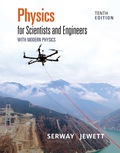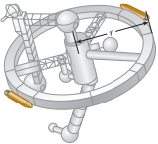
Concept explainers
Why is the following situation impossible? A space station shaped like a giant wheel (Fig. P11.28, page 306) has a radius of r = 100 m and a moment of inertia of 5.00 × 108 kg · m2. A crew of 150 people of average mass 65.0 kg is living on the rim, and the station’s rotation causes the crew to experience an apparent free-fall acceleration of g. A research technician is assigned to perform an experiment in which a ball is dropped at the rim of the station every 15 minutes and the time interval for the ball to drop a given distance is measured as a lest to make sure the apparent value of g is correctly maintained. One evening, 100 average people move to the center of the station for a union meeting. The research technician, who has already been performing his experiment for an hour before the meeting, is disappointed that he cannot attend the meeting, and his mood sours even further by his boring experiment in which every time interval for the dropped ball is identical for the entire evening.
Figure P11.28

Trending nowThis is a popular solution!

Chapter 11 Solutions
EBK PHYSICS FOR SCIENTISTS AND ENGINEER
- Point charges q1 = 50 µC and q2 = −25 µC are placed 1.0 m apart. What is the magnitude of the force on a third charge q3 = 40 µC placed midway between q1 and q2? (The prefix µ =10−6 C.)arrow_forwardThe de-excitation of a state occurs by competing emission and relaxation processes. If the relaxation mechanisms are very effective:a) the emission of radiation is largeb) the emission of radiation is smallc) the emission occurs at a shorter wavelengthd) the de-excitation occurs only by emission processesarrow_forwardm C A block of mass m slides down a ramp of height hand collides with an identical block that is initially at rest. The two blocks stick together and travel around a loop of radius R without losing contact with the track. Point A is at the top of the loop, point B is at the end of a horizon- tal diameter, and point C is at the bottom of the loop, as shown in the figure above. Assume that friction between the track and blocks is negligible. (a) The dots below represent the two connected blocks at points A, B, and C. Draw free-body dia- grams showing and labeling the forces (not com ponents) exerted on the blocks at each position. Draw the relative lengths of all vectors to reflect the relative magnitude of the forces. Point A Point B Point C (b) For each of the following, derive an expression in terms of m, h, R, and fundamental constants. i. The speed of moving block at the bottom of the ramp, just before it contacts the stationary block ii. The speed of the two blocks immediately…arrow_forward
 Principles of Physics: A Calculus-Based TextPhysicsISBN:9781133104261Author:Raymond A. Serway, John W. JewettPublisher:Cengage Learning
Principles of Physics: A Calculus-Based TextPhysicsISBN:9781133104261Author:Raymond A. Serway, John W. JewettPublisher:Cengage Learning Physics for Scientists and EngineersPhysicsISBN:9781337553278Author:Raymond A. Serway, John W. JewettPublisher:Cengage Learning
Physics for Scientists and EngineersPhysicsISBN:9781337553278Author:Raymond A. Serway, John W. JewettPublisher:Cengage Learning Physics for Scientists and Engineers with Modern ...PhysicsISBN:9781337553292Author:Raymond A. Serway, John W. JewettPublisher:Cengage Learning
Physics for Scientists and Engineers with Modern ...PhysicsISBN:9781337553292Author:Raymond A. Serway, John W. JewettPublisher:Cengage Learning Physics for Scientists and Engineers, Technology ...PhysicsISBN:9781305116399Author:Raymond A. Serway, John W. JewettPublisher:Cengage Learning
Physics for Scientists and Engineers, Technology ...PhysicsISBN:9781305116399Author:Raymond A. Serway, John W. JewettPublisher:Cengage Learning Glencoe Physics: Principles and Problems, Student...PhysicsISBN:9780078807213Author:Paul W. ZitzewitzPublisher:Glencoe/McGraw-Hill
Glencoe Physics: Principles and Problems, Student...PhysicsISBN:9780078807213Author:Paul W. ZitzewitzPublisher:Glencoe/McGraw-Hill Physics for Scientists and Engineers: Foundations...PhysicsISBN:9781133939146Author:Katz, Debora M.Publisher:Cengage Learning
Physics for Scientists and Engineers: Foundations...PhysicsISBN:9781133939146Author:Katz, Debora M.Publisher:Cengage Learning





